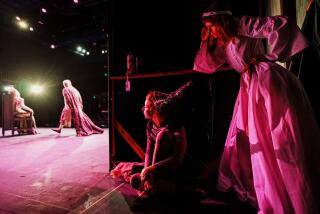Russian Ballet’s ‘Swan Lake’ Lacks Distinction
- Share via
Nostalgia for communism, or Russian culture under communism, just might be the last perversion of the 20th century--and it’s writ large over the Russian National Ballet “Swan Lake.”
At the Thousand Oaks Civic Arts Plaza on Thursday, the company’s program data listed 19th century icons Marius Petipa and Lev Ivanov as the choreographers, with the up-on-pointe national dances in Act 3 credited to former Bolshoi artistic director Yuri Grigorovich. However, the Rothbart-Siegfried duets in the second and fourth acts also came from Grigorovich and the production proved distinctly Soviet in all its other major choices--from the happy ending once mandated by the Kremlin through the deletion of essential mime scenes and the interpolation of a Jester to add technical flash to Acts 1 and 3.
In dancing style, too, this “Swan Lake” reflected 20th century Russian priorities--but without an iota of Bolshoi vitality or Kirov poetry. Those unmistakable high backs should have been a launching platform for deeply sculpted arm movement rather than just a passive support for the company’s uniformly shallow gestural statements. Footwork, too, remained bland: clean and on-the-counts but with no distinctive quality of movement or expressive specificity.
Thus Elena Scheglova looked the same when dancing her White Swan pique turns as her Black Swan pique turns; the only difference she created between Odette and Odile involved the latter’s enhanced directional contrasts--left/right, front/back, etc. Did she love Siegfried? Did she love dancing? Who could tell from the impenetrable, self-absorbed funk of her performance.
Yes, she executed the steps reliably, which put her ahead of her insufferably mannered, technically uneven Siegfried, Konstantin Osin. But how emotionally vacant she and her colleagues seemed in their fidelity to the letter of Soviet classicism--with only Vladimir Gusev (Rothbart), Alexander Rupyshev (the Jester) and Sofia Tomilina (the Taratentella dancer) escaping the sense of remote, passionless ritual to dance with spirit and flair.
Times change and even the ultraconservative Kirov has been investigating the evidence that what it thinks is Petipa often isn’t. Russian National Ballet may publish program notes about “upholding the grand national tradition of the major Russian ballet works” but the tradition on view can no longer be graced with the names Petipa/Ivanov nor is it being upheld with any great conviction.
Modest in scale, the production can be considered mostly as part of a reflexive backlash, comforting perhaps to those who grew up watching a Grigorovich or Vinogradov “Swan Lake,” but never deeply in touch with the music, story or capabilities of the dancers. Lev Solodovnikov’s simple but lushly painted storybook sets may create an environment for magical romance, but what we get is merely an exercise in denial.
*
* Russian National Ballet dances “Swan Lake” today at 2 p.m. and “Sleeping Beauty” at 8 p.m., repeating the latter on Sunday at 2 p.m. Cerritos Center for the Performing Arts, 12700 Center Court Drive. $27-$42. (800) 300-4345.
More to Read
The biggest entertainment stories
Get our big stories about Hollywood, film, television, music, arts, culture and more right in your inbox as soon as they publish.
You may occasionally receive promotional content from the Los Angeles Times.










